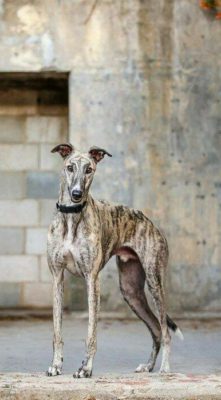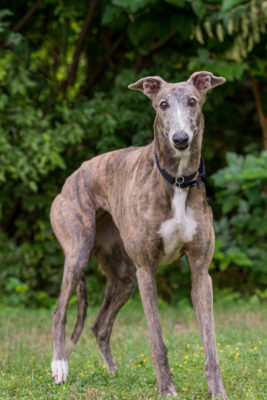Greyhound

Greyhound dogs are extremely gentle, loyal, and affectionate to people. The English Greyhound is intelligent and independent, in many ways similar even to a cat. They are genuinely aristocrats, calm and polite. English Greyhound perfectly understands the atmosphere in the house. And if there was a quarrel between the owners, the dog can defuse the situation. Greyhounds can become shy because of mistreatment, even if it is not intentional.
Table of Contents
Breed Information
| Another Name | English Greyhound |
| Origin | (Widespread) |
| Height | Males 71-76 cm Females 68-71 cm |
| Weight | Males 27-40 kg Females 26-34 kg |
| Fur | Short |
| Color | Black, white, red, pale, tiger |
| Lifespan | 10-14 years |
| FCI Classification | Sighthounds |
| Group | Hunting dogs |
| Price | $500-1500 |
Breed Photos
Origin History
The Greyhound, also known as the English greyhound, is truly a legendary dog. It is the only dog breed mentioned in the Bible. It was praised by Roman and Greek poets in their works. Archaeologists have discovered images of greyhound-like dogs on the murals of ancient temples in ancient Egypt. Until recently, scientists believed that the Greyhound had descendants in Egypt, but these hypotheses were debunked by a study conducted in 2004. DNA analysis revealed that the Greyhound had nothing in common with Egyptian dogs.
Most likely, the breed came to the British Isles with the Celtic tribes from mainland Europe. Whether this theory is true or not is anyone’s guess. But it is certain that since the 10th century A.D., the Greyhound was very popular among English nobility and common people.
The dog was so loved and honored that there were laws that protected the English Greyhound. According to the law, a man who killed a greyhound paid for this deed with his head. The Greyhound is noted for its unsurpassed speed over short distances, so it has been involved in racing and hunting since the Middle Ages. In 1014, the “Law of the Forest” came out, which prohibited farmers from freely hunting in the woods with English Greyhounds. Then the Greyhound rose to a step higher in its privilege: only the nobility could have such a breed.
Toward the eighteenth century, the Greyhound gradually disappeared due to inbreeding. To save the breed, the dog breeder Lord Orford took decisive measures. He bred Greyhounds with English bulldog blood to make them even tougher.
Over time, three Greyhounds have formed: the hunting line, the running line, and the show dog line. According to the rules, dogs from different lines are not crossed with each other to not lose the valuable characteristics of the breed. The line of show dogs not only performs at shows but also becomes a pet.
Appearance
The Greyhound is a large, muscular, strong dog. The dog’s symmetrical silhouette gives it tremendous strength. Relatively tall, it has a slender build. The coat is short, smooth, shiny. The color is varied. The dog’s head is elongated, with the ears pushed back in a relaxed state. The eyes are round; their anatomy contributes to excellent vision, essential for successful hunting. The neck is long and flared up toward the body. The back is straight and convex at the loin. The chest is large and deep. The tail is long, curved at the end.
The English Greyhound has long, powerful, and athletic limbs. Its long strides allow it to cover a large territory in a very short time. The Greyhound exudes a certain nobility, manifested in unusual grace and agility.
Character
Greyhound dogs are extremely gentle, loyal, and affectionate to people. The English Greyhound is intelligent and independent, in many ways similar even to a cat. They are genuinely aristocrats, calm and polite. English Greyhound perfectly understands the atmosphere in the house. And if there was a quarrel between the owners, the dog can defuse the situation. Greyhounds can become shy because of mistreatment, even if it is not intentional.
Greyhound has a dual nature: on the street playful and agile dog, and at home – a permanent resident of the couch. The dog is not a nuisance and does not make a mess in the apartment because, on the walk, he splashes out his energy. Greyhounds are very vulnerable: the dog is acutely sensitive to abuse. They tend to get along well with children, although you can’t call them an excellent “babysitter”. A greyhound can get along with cats in the same house but may take yard cats as prey.
Care
The English Greyhound does not require much care for its short coat – it is enough to brush it several times a month. It is necessary to monitor the skin condition for scratches, as it is thin and can easily get damaged. Nails should be trimmed once a week. It is better to choose parks and groves as a place for walking. Since the Greyhound has hunter’s blood in it, the dog should not be overlooked.
Training
Because the Greyhound does not have leadership qualities, training is smooth and painless for the owner and the dog itself. Suppressing the instincts to chase prey can cause difficulties. The dog must be socialized as early as possible. English Greyhound will suit the same calm and self-sufficient owner. Under no circumstances should physical force be used in Greyhound’s education: he will remember it and stay wary.
Common Diseases
Greyhounds, in general, are in good health, but like all animals, they are prone to some conditions. A list of the most common diseases among English Greyhounds:
- hypothyroidism;
- osteosarcoma;
- stomach torsion;
- neuropathy;
- meningoencephalitis;
- hip dysplasia.
Nutrition
A greyhound is undemanding in nutrition, but a dog should not be overfed. A standard “dog’s menu” is suitable for English Greyhounds: many animal meat (preferably lean), boneless sea fish, and by-products.
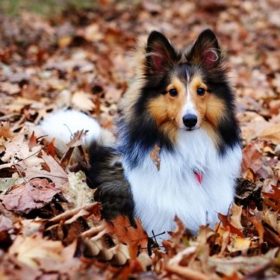 Shetland Sheepdog
Shetland Sheepdog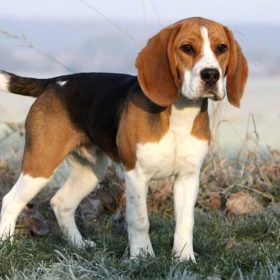 Beagle
Beagle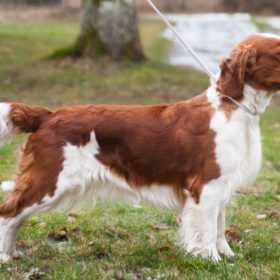 Welsh Springer Spaniel
Welsh Springer Spaniel Pražský Krysařík
Pražský Krysařík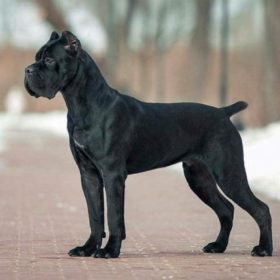 Cane Corso
Cane Corso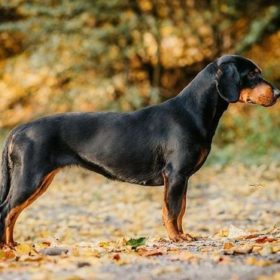 Slovenský Kopov
Slovenský Kopov